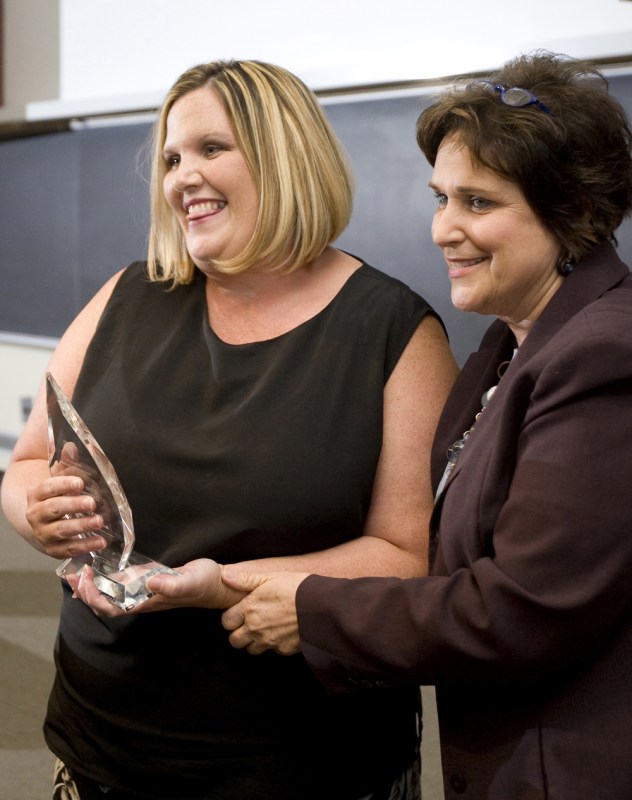
LeAnn Grimes, R.N., left, is presented with the Center for Frontline Leadership's Future of Nursing Award, by JoNeil Smith, M.S.N., R.N. (photo by Joe Howell)
Innovative nurse staffing model continues to draw praise, interest
Vanderbilt Medical Center’s 4 East unit cares for a wide variety of female patients, and a few years ago its staffing model just wasn’t keeping up with demand.
“Work was not getting done, nurses were not clocking out on time and patients had more complaints,” recalled Leann Grimes, R.N. “We had good nurses leaving because they felt they were bombarded from the time they clocked in to the time they clocked out.”
Grimes, a charge nurse on the unit, recognized the problem and developed a new staffing model to care for the unit’s ever-changing patient population.
4 East is a 36-bed obstetrics and gynecology unit that also cares for off-service female patients. Most patients stay 1-3 days, so the unit has a high turnover rate. It averages 15-16 admissions and discharges in a 12-hour shift.
The previous model determined the number of nurses needed solely by the number of patients on the unit.
“If we had 20 patients, we needed four nurses. It didn’t matter the acuity of the patient,” Grimes explained.
The new model staffs the unit based on patient acuity and constantly keeps up with variable acuity levels.
“The old way is fine if you have all low-acuity patients. The problem is when acuity shoots up. If patients are sicker, they need more care, and more care means more nurses,” Grimes said.
To develop the new model, Grimes recorded nine months of data showing how acuity fluctuated on the unit. She also consulted with Ann Underhill, assistant director of Finance, to discuss the budget.
“We can always say we need more staff, but we had to prove it. I knew we needed to have her buy-in and budget approval. The biggest impact was the data. It clearly showed that when acuity was high, we needed another nurse,” Grimes said.
Following guidelines from the Association of Women’s Health, Obstetric and Neonatal Nurses (AWHONN), high-risk post-partum patients are staffed at a ratio of four patients to one nurse. Low-risk post-partum patients are six to one, antepartum patients are three to one, and gynecology, oncology and off-service patients are four to one.
Grimes revised the charge nurse sheet to include space for acuity, and every two hours, the ratios are recalculated and staff is adjusted accordingly.
“It’s very fair, concrete and standardized. Nurses feel that the number of staff matches the acuity and everyone’s assignment is equally distributed,” she said.
Grimes completed this project as part of the Frontline Nursing Leadership workshop.
“We were told to pick something small but I wanted to do something I cared about,” she said. “It shows that everyone has ideas, and leadership can come at all levels. I’m tickled with the results. My input actually mattered and has made a difference.”
For her efforts, Grimes was one of three national winners of the Center for Frontline Nursing Leadership’s Future of Nursing Award. Hospitals around the nation have taken notice of Grimes’ innovative staffing model, and she has participated in many presentations and seminars.
The new model has been in place for two years and is a proven success.
“Turnover is down and patient satisfaction is up. When you have happy nurses, you will have happy patients,” Grimes said.













